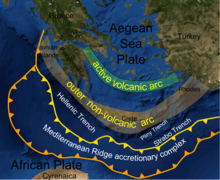Hellenic subduction zone

The Hellenic subduction zone (HSZ) is the
Surface expression

When the subduction zone was originally identified in the 1970s, it was thought that the
The 2,000 km long Mediterranean Ridge is the fastest growing accretionary complex in the world.[5] The size of the complex is a result of a combination of fast rate of convergence combined with the unusually thick sequence of sediments deposited on the Neotethyan oceanic crust, which is thought to be of Jurassic age. The northern edge of the ridge is generally interpreted as a northward-moving backthrust. The degree to which the observed thrust faults within the ridge connect directly with the subduction interface remains unclear, due to poor seismic imaging caused by the presence of a thick layer of Messinian salt.
Slab geometry
Tomographic data indicate that there is no link between the descending HSZ slab and those associated with either the
Magmatism
The subduction of the African Plate slab has led to the development of a
Development
There is evidence that more than 1500 km of Neotethyan oceanic crust has been subducted along this structure or earlier versions of it.[9] Broadly northward subduction of Neotethys beneath Eurasia was already established in the Late Cretaceous. This proceeded by the progressive closing up of different parts of Neotethys with the accretion of intervening continental areas to Eurasia.[10] This involves backstepping of the subduction zone southwards across each microcontinent, so maintaining a continuous slab, as suggested by the tomographic results.[6]
The onset of subduction of southern Neotethys was diachronous, starting in the east in the latest Eocene (ca. 35 Ma), beneath Crete in the early Miocene and in the Pliocene (ca. 4 Ma) at the western end of the HSZ beneath the Ionian Islands. The initially near planar slab began to fold in the latest Oligocene (25–23 Ma), associated with differential slab rollback and trench retreat, causing major clockwise rotation of western Greece. From mid-Miocene times (ca. 15 Ma) the slab curvature became more pronounced and southwestern Turkey began to rotate anticlockwise. During the period a major tear developed between the main part of the HSZ and the Western Cyprus zone, forming a slab window in the deeper part of the slab.[6]
Currently, the rate of movement along the HSZ is estimated to be about 35 mm per year. However, the overall convergence between the African and Eurasian plates is only about 5 mm per year. This discrepancy is consistent with continuing slab rollback and relatively fast southward movement of the Aegean Sea Plate, accompanied by ongoing extension within that plate.[11]
